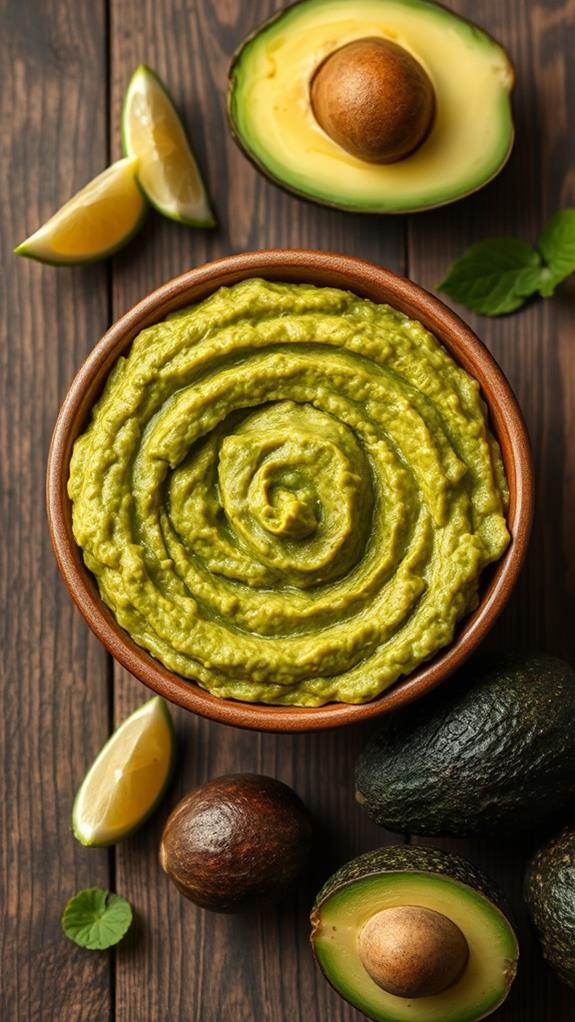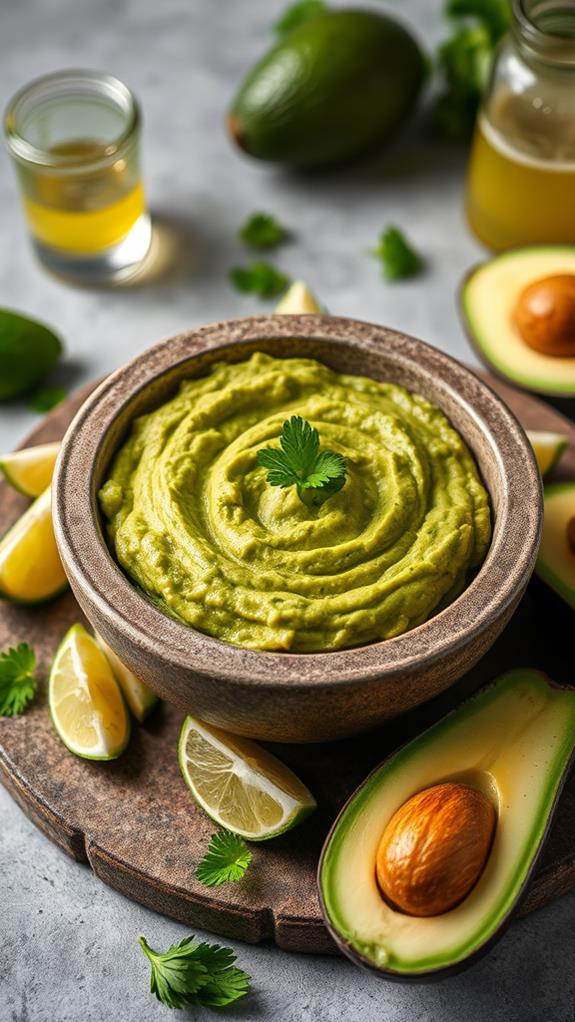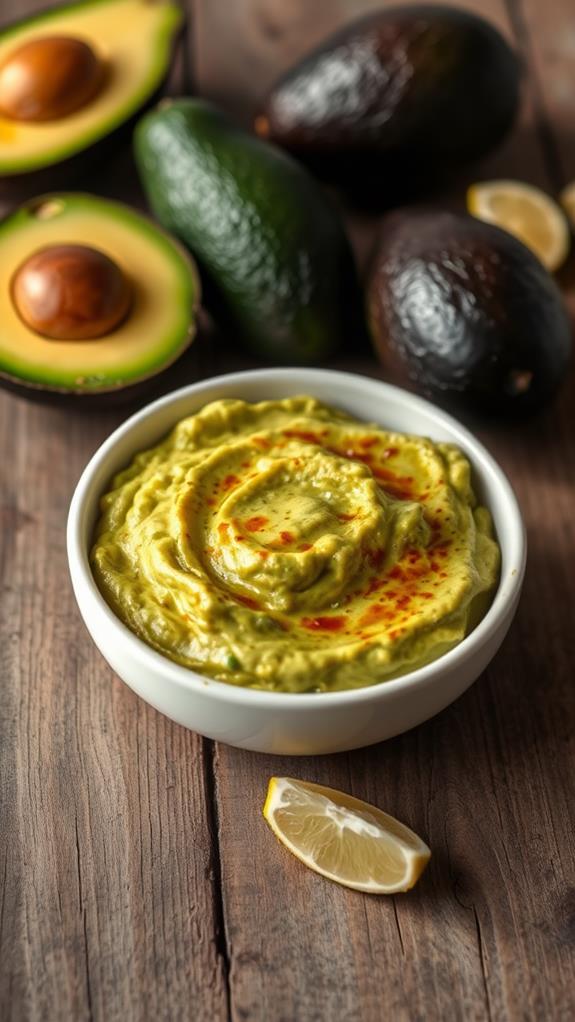Is Brown Guacamole Safe to Eat
Brown guacamole is generally safe to eat, but you'll need to assess its overall condition. The browning is caused by oxidation, a natural process that doesn't necessarily indicate spoilage. However, you should check for signs of mold, off-putting odors, or sliminess, which could signal bacterial growth. If the guacamole has been refrigerated for more than 3-4 days, it's best to discard it. Adding lime juice can slow down oxidation and extend shelf life. Proper storage techniques, like using airtight containers or plastic wrap pressed directly onto the surface, can help maintain freshness. To fully understand the safety and quality of your guacamole, consider several key factors.
This post may contain affiliate links. If you make a purchase through these links, I may earn a commission at no additional cost to you. Additionally, portions of this post may be generated using artificial intelligence (AI) technology. While we strive for accuracy, please be aware that AI-generated content may not always be perfect and should be fact-checked when necessary.
The Spatula Scoops
- Brown guacamole is generally safe to eat if it's only discolored due to oxidation.
- Examine the texture, smell, and storage duration to determine if the guacamole has spoiled.
- Mold growth, separation, dark spots, or off-putting odors are signs of unsafe guacamole.
- Browning doesn't necessarily indicate bacterial growth or spoilage.
- Scraping off the brown layer can reveal fresh guacamole underneath, but proper storage prevents browning.
Why Guacamole Turns Brown

Anyone who's made guacamole knows it can quickly turn brown. This discoloration is a natural process called oxidation, which occurs when the flesh of the avocado is exposed to air. The culprit behind this reaction is an enzyme called polyphenol oxidase, present in avocados and many other fruits and vegetables. This process is similar to what happens with chocolate, where chocolate bloom can affect appearance but not necessarily safety or quality.
When you cut open an avocado, you're breaking cell walls and allowing oxygen to interact with the enzyme. This triggers a chemical reaction that produces melanin, the same pigment responsible for tanning your skin. The brown color you see is simply the result of this melanin formation.
It's important to note that while the browning might look unappetizing, it doesn't necessarily mean your guacamole has gone bad. However, it can affect the taste and texture over time. To slow down this process, you can add acidic ingredients like lime juice, which lowers the pH level and inhibits the enzyme's activity. Covering the guacamole with plastic wrap pressed directly onto the surface can also help by reducing air exposure. These techniques can extend your guacamole's fresh appearance and flavor for longer periods.
Safety of Brown Guacamole
While the appearance of brown guacamole might be off-putting, it's generally safe to eat. The browning process, known as oxidation, is a natural reaction that occurs when avocados are exposed to air. It doesn't necessarily indicate spoilage or bacterial growth. However, you should use your judgment and consider a few factors before consuming brown guacamole. Similar to oatmeal safety considerations, it is crucial to trust your senses when evaluating guacamole quality.
First, examine the guacamole's texture and smell. If it looks moldy, has an off-putting odor, or feels slimy, it's best to discard it. These are signs of potential bacterial growth. Additionally, consider how long the guacamole has been stored. If it's been in the refrigerator for more than three to four days, it is safer to throw it away, even if it looks fine.
To prevent browning and extend the shelf life of your guacamole, you can try a few methods. Adding lime juice helps slow oxidation due to its acidity. Storing guacamole with plastic wrap pressed directly onto its surface can reduce air exposure. You can also add the avocado pit to the guacamole, which some believe helps maintain freshness.
Preventing Browning in Guacamole

To prevent your guacamole from turning brown, you've got several effective strategies at your disposal. You can start by adding acidic ingredients like lime or lemon juice, which slow down the oxidation process responsible for browning. Proper storage techniques, such as using airtight containers or plastic wrap pressed directly onto the surface of the guacamole, help limit exposure to air. These storage methods are similar to those used for preserving pickles and other vegetables in brine. Additionally, you can employ oxygen-limiting methods like covering the guacamole with a thin layer of water or placing an avocado pit in the mixture to reduce contact with air and maintain its fresh, green appearance.
Add Acidic Ingredients
Guacamole's vibrant green color can be preserved by adding acidic ingredients. These ingredients help slow down the oxidation process that causes browning. You'll want to incorporate citrus fruits like lemon or lime juice into your recipe. The acidity in these fruits acts as a natural preservative, keeping your guacamole fresher for longer.
When preparing your guacamole, squeeze fresh lemon or lime juice directly onto the avocado flesh as soon as you cut it open. This immediate application creates a protective barrier against oxygen exposure. For every two to three avocados, use about one tablespoon of citrus juice. You can also experiment with other acidic ingredients like vinegar or tomatoes, which contain citric acid.
It's important to note that while these acidic additions help maintain the green color, they also affect the flavor profile of your guacamole. Lemon tends to have a slightly milder taste compared to lime, so consider your preference when choosing. Remember, the goal is to strike a balance between preserving the color and maintaining the desired taste. By incorporating these acidic elements, you'll extend the visual appeal of your guacamole without compromising its flavor.
Proper Storage Techniques
Once you've prepared your guacamole, proper storage is essential to maintain its freshness and prevent browning. The key is to minimize exposure to air, which causes oxidation and leads to that unappetizing brown color. You'll want to store your guacamole in an airtight container, pressing plastic wrap directly onto the surface to create a barrier against oxygen.
Here's a quick reference guide for storing guacamole:
| Storage Method | Duration | Notes |
|---|---|---|
| Refrigerator | 1-2 days | Use airtight container |
| Freezer | 3-4 months | Add extra lemon juice |
| Room temperature | 1-2 hours | For immediate serving |
When refrigerating, place your guacamole in the coldest part of your fridge, typically the back. If you're planning to freeze it, consider portioning it into smaller containers for easier thawing. Remember, frozen guacamole may lose some of its texture, but it'll still be safe to eat and flavorful. For short-term storage, you can also try the water method: cover the surface of your guacamole with a thin layer of water, which acts as a natural barrier against oxidation. Just pour off the water and stir before serving.
Oxygen-Limiting Methods
While proper storage techniques are crucial, implementing oxygen-limiting methods can greatly extend your guacamole's freshness and prevent browning. One effective approach is to create a barrier between the guacamole and air. You can achieve this by pressing plastic wrap directly onto the surface of the dip, ensuring there are no air pockets. This technique, known as "contact wrapping," minimizes oxidation, which is the primary cause of browning.
Another method involves using acidic ingredients to slow down the oxidation process. Adding extra lime or lemon juice to your guacamole not only enhances flavor but also helps preserve its vibrant green color. The citric acid in these fruits acts as a natural antioxidant, inhibiting the enzymes responsible for browning.
You can also try the water method, where you pour a thin layer of water over the guacamole's surface before refrigerating. When you're ready to eat, simply pour off the water and give the dip a quick stir. This creates an effective oxygen barrier without altering the guacamole's texture or taste. By employing these oxygen-limiting techniques, you'll considerably extend your guacamole's shelf life and maintain its appetizing appearance.
Myths About Brown Guacamole
Despite its widespread popularity, brown guacamole is often surrounded by myths and misconceptions. You've probably heard that brown guacamole is spoiled or unsafe to eat, but this isn't necessarily true. The browning is simply a result of oxidation, which doesn't affect the safety or nutritional value of the guacamole.
Another common myth is that adding extra lime juice will prevent browning indefinitely. While citrus can slow the process, it's not a foolproof method. You might also encounter the belief that brown guacamole always tastes bad. In reality, the flavor may change slightly, but it's often still perfectly edible.
Some people think that if guacamole turns brown, it means it's full of preservatives. This is false; even all-natural guacamole will brown when exposed to air. Lastly, there's a misconception that you can scrape off the brown layer and the rest will be fine. While this can work to an extent, it's better to prevent browning altogether through proper storage techniques. Remember, these myths can impact consumer behavior and product perception, which are significant factors in content strategy and search engine optimization (SEO) for food-related websites.
Signs of Spoiled Guacamole

When it comes to guacamole, you'll want to know how to spot the signs of spoilage. While brown discoloration isn't always a concern, other indicators can help you determine if your guacamole has gone bad.
Look out for these telltale signs:
| Visual Signs | Olfactory Signs |
|---|---|
| Mold growth | Sour odor |
| Separation | Rancid smell |
| Dark spots | Fermented aroma |
| Excessive browning | Off-putting scent |
If you notice any of these signs, it's best to discard the guacamole. Mold growth, appearing as fuzzy patches of white, green, or black, is a clear indicator of spoilage. Separation, where liquid pools on top, suggests bacterial growth. Dark spots beyond normal browning can indicate decay.
Your nose is a powerful tool in detecting spoilage. A sour or rancid smell is a red flag, signaling that harmful bacteria have proliferated. A fermented aroma or any off-putting scent that doesn't match fresh guacamole's typical smell should make you wary.
Reviving Discolored Guacamole
A discolored guacamole doesn't always mean it's spoiled. If you've noticed your dip turning brown, there are a few ways to revive it. First, try scraping off the top layer where oxidation has occurred. This process, known as enzymatic browning, is similar to what happens when you cut an apple. Underneath, you'll often find fresh, green guacamole.
If the browning is more extensive, you can try adding acid to slow down further discoloration. Squeeze some fresh lemon or lime juice over the surface and mix it in. This not only helps preserve the color but can also enhance the flavor. For a more thorough revival, transfer the guacamole to a food processor or blender. Add a splash of lemon juice and a fresh avocado, then pulse until smooth. This method redistributes the brown portions and introduces new, vibrant color.
Frequently Asked Questions
Can Brown Guacamole Be Used in Cooking Recipes?
You can use brown guacamole in cooking recipes, but it's important to weigh a few factors. While the brown color doesn't necessarily indicate spoilage, it may affect the dish's appearance and taste. If the guacamole is freshly made and has only slightly browned, it's generally safe to utilize. However, if it's been stored for a while or has an off odor, it's best to discard it. For ideal outcomes, use fresh guacamole in your recipes whenever possible.
Does Brown Guacamole Have a Different Nutritional Value Than Fresh Guacamole?
When it comes to nutritional value, you'll find that brown guacamole isn't considerably different from fresh guacamole. The browning is simply oxidation, which doesn't affect the nutrient content. You're still getting the same healthy fats, fiber, vitamins, and minerals. However, if the browning is extensive or accompanied by off-odors, it might indicate spoilage. In that case, some nutrients could be degraded. It's best to consume guacamole when it's fresh for ideal taste and nutritional benefits.
How Long Can Brown Guacamole Be Safely Stored in the Refrigerator?
You'd be shocked to know that brown guacamole can last longer than you think! Typically, you can safely store it in the refrigerator for 3-4 days. However, it's essential to keep it in an airtight container to prevent further oxidation. While the brown color might not look appetizing, it doesn't necessarily mean the guacamole has gone bad. To extend its shelf life, you can add a thin layer of lemon juice or water on top before sealing.
Are There Any Health Benefits to Eating Oxidized Avocado in Guacamole?
When it comes to oxidized avocado in guacamole, you're not likely to gain additional health benefits. The brown color is due to enzymatic browning, which doesn't materially alter the nutritional content. However, you'll still get the benefits of fresh avocado, including healthy fats, fiber, and various vitamins and minerals. The oxidation process might slightly reduce vitamin C content, but it won't dramatically change the overall nutritional profile. It's safe to eat, but for the best taste and appearance, fresh is preferable.
Can Dogs or Cats Safely Eat Brown Guacamole?
Like a ticking time bomb, brown guacamole can be dangerous for your furry friends. You shouldn't feed it to dogs or cats. Avocados contain persin, a substance that's toxic to many animals. While the brown color itself isn't harmful, it indicates the guacamole's no longer fresh. This increases the risk of bacterial growth, which can make your pets sick. It's best to keep guacamole, especially if it's oxidized, away from your four-legged companions to guarantee their safety.
Conclusion
You've learned that brown guacamole is generally safe to eat, but it's best consumed within 1-2 days of preparation. Notably, avocados contain an enzyme called polyphenol oxidase, which causes browning when exposed to air. To keep your guacamole fresh longer, use proper storage techniques and additives like citrus juice. Remember, while discoloration doesn't always mean spoilage, it's vital to check for other signs of deterioration. When in doubt, it's safer to discard questionable guacamole to avoid potential foodborne illness.





